TOYOTA YARIS HYBRID 2015 Owners Manual
Manufacturer: TOYOTA, Model Year: 2015, Model line: YARIS HYBRID, Model: TOYOTA YARIS HYBRID 2015Pages: 492, PDF Size: 21.93 MB
Page 441 of 492
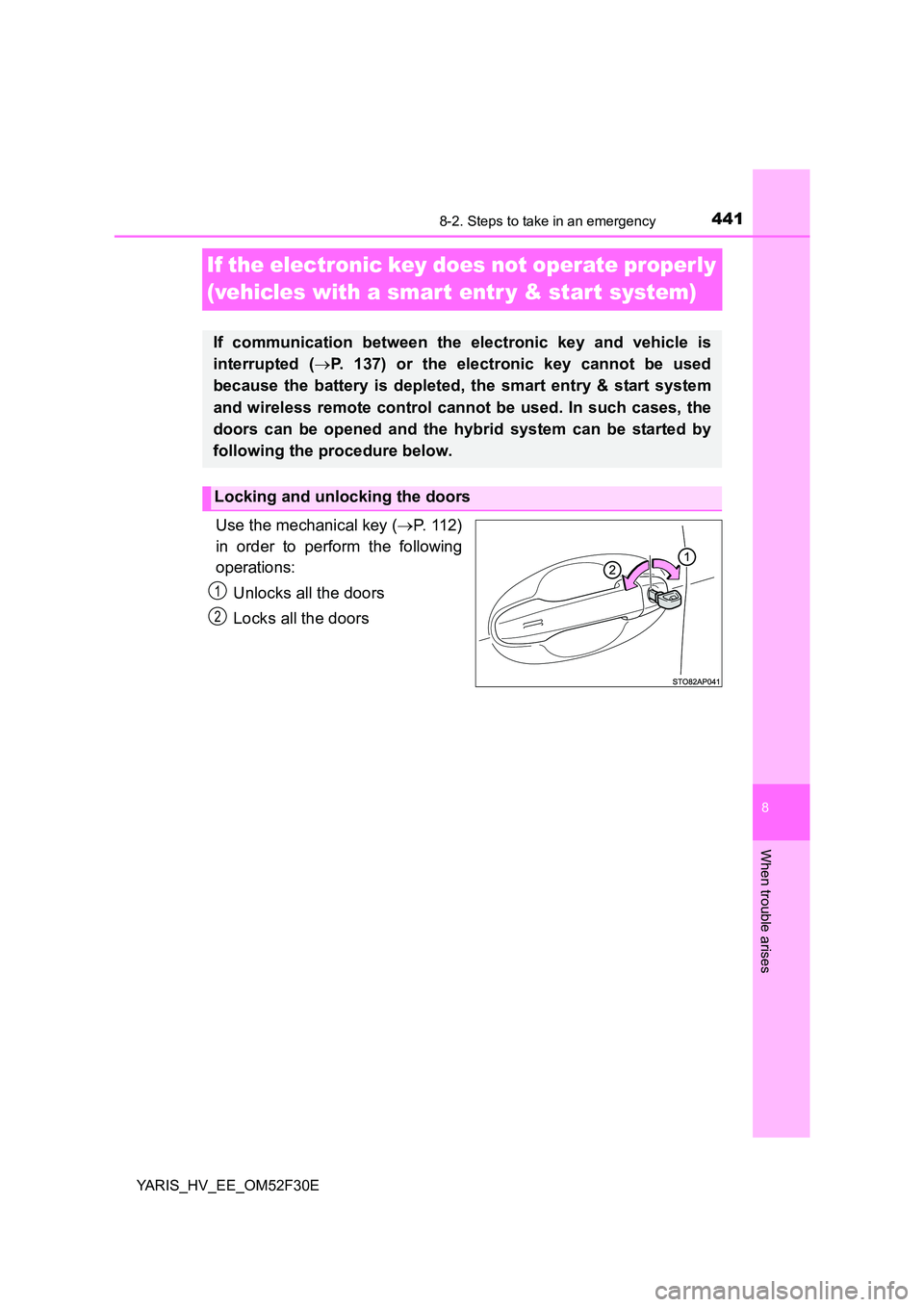
4418-2. Steps to take in an emergency
8
When trouble arises
YARIS_HV_EE_OM52F30E
If the electronic key does not operate properly
(vehicles with a smart entr y & start system)
Use the mechanical key ( →P. 112)
in order to perform the following
operations:
Unlocks all the doors
Locks all the doors
If communication between the electronic key and vehicle is
interrupted ( →P. 137) or the electronic key cannot be used
because the battery is depleted, the smart entry & start system
and wireless remote control cannot be used. In such cases, the
doors can be opened and the hybrid system can be started by
following the procedure below.
Locking and unlocking the doors
1
2
Page 442 of 492
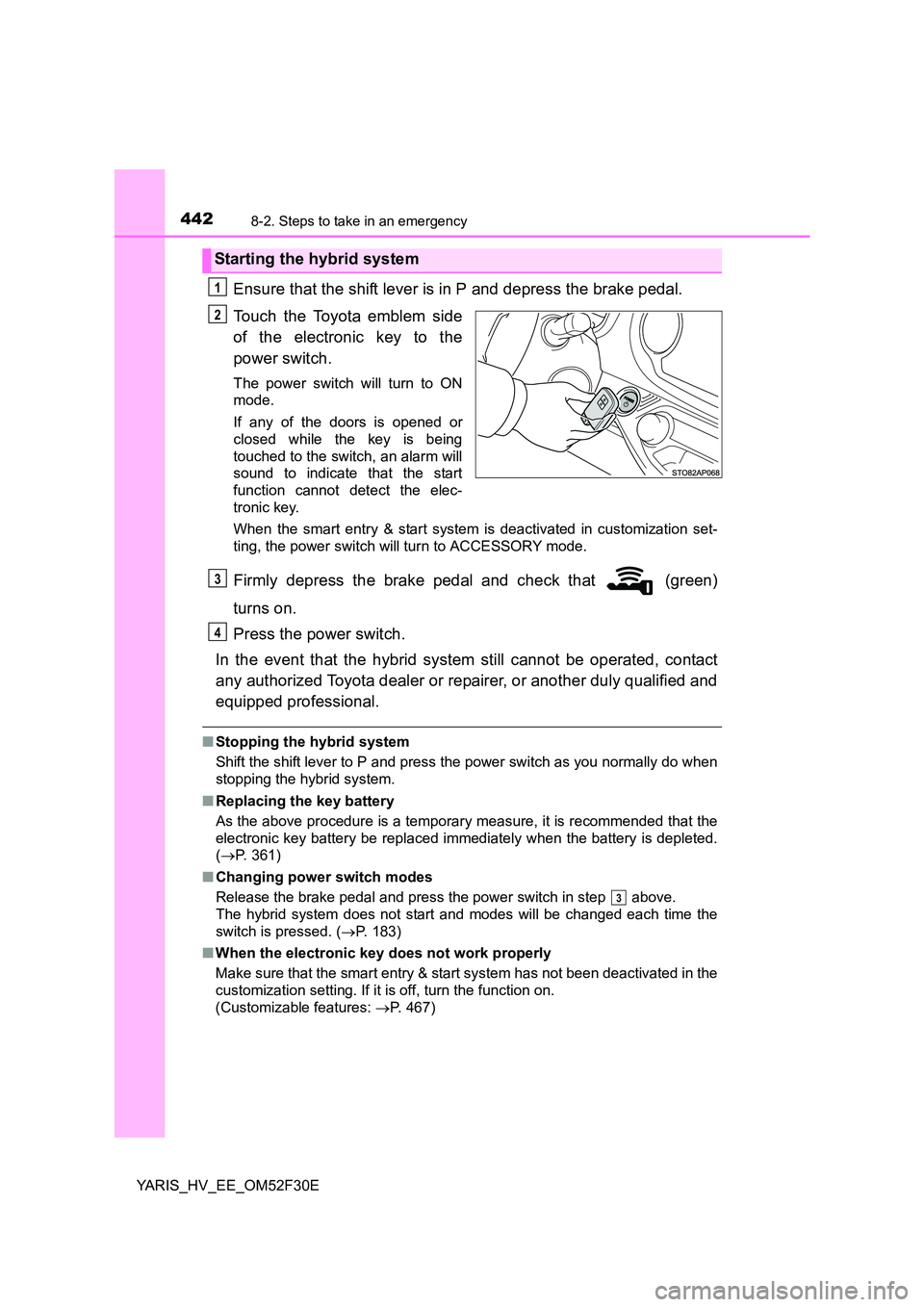
4428-2. Steps to take in an emergency
YARIS_HV_EE_OM52F30E
Ensure that the shift lever is in P and depress the brake pedal.
Touch the Toyota emblem side
of the electronic key to the
power switch.
The power switch will turn to ON
mode.
If any of the doors is opened or
closed while the key is being
touched to the switch, an alarm will
sound to indicate that the start
function cannot detect the elec-
tronic key.
When the smart entry & start system is deactivated in customization set-
ting, the power switch will turn to ACCESSORY mode.
Firmly depress the brake pedal and check that (green)
turns on.
Press the power switch.
In the event that the hybrid system still cannot be operated, contact
any authorized Toyota dealer or repairer, or another duly qualified and
equipped professional.
■ Stopping the hybrid system
Shift the shift lever to P and press the power switch as you normally do when
stopping the hybrid system.
■ Replacing the key battery
As the above procedure is a temporary measure, it is recommended that the
electronic key battery be replaced immediately when the battery is depleted.
( →P. 361)
■ Changing power switch modes
Release the brake pedal and press the power switch in step above.
The hybrid system does not start and modes will be changed each time the
switch is pressed. ( →P. 183)
■ When the electronic key does not work properly
Make sure that the smart entry & start system has not been deactivated in the
customization setting. If it is off, turn the function on.
(Customizable features: →P. 467)
Starting the hybrid system
1
2
3
4
3
Page 443 of 492
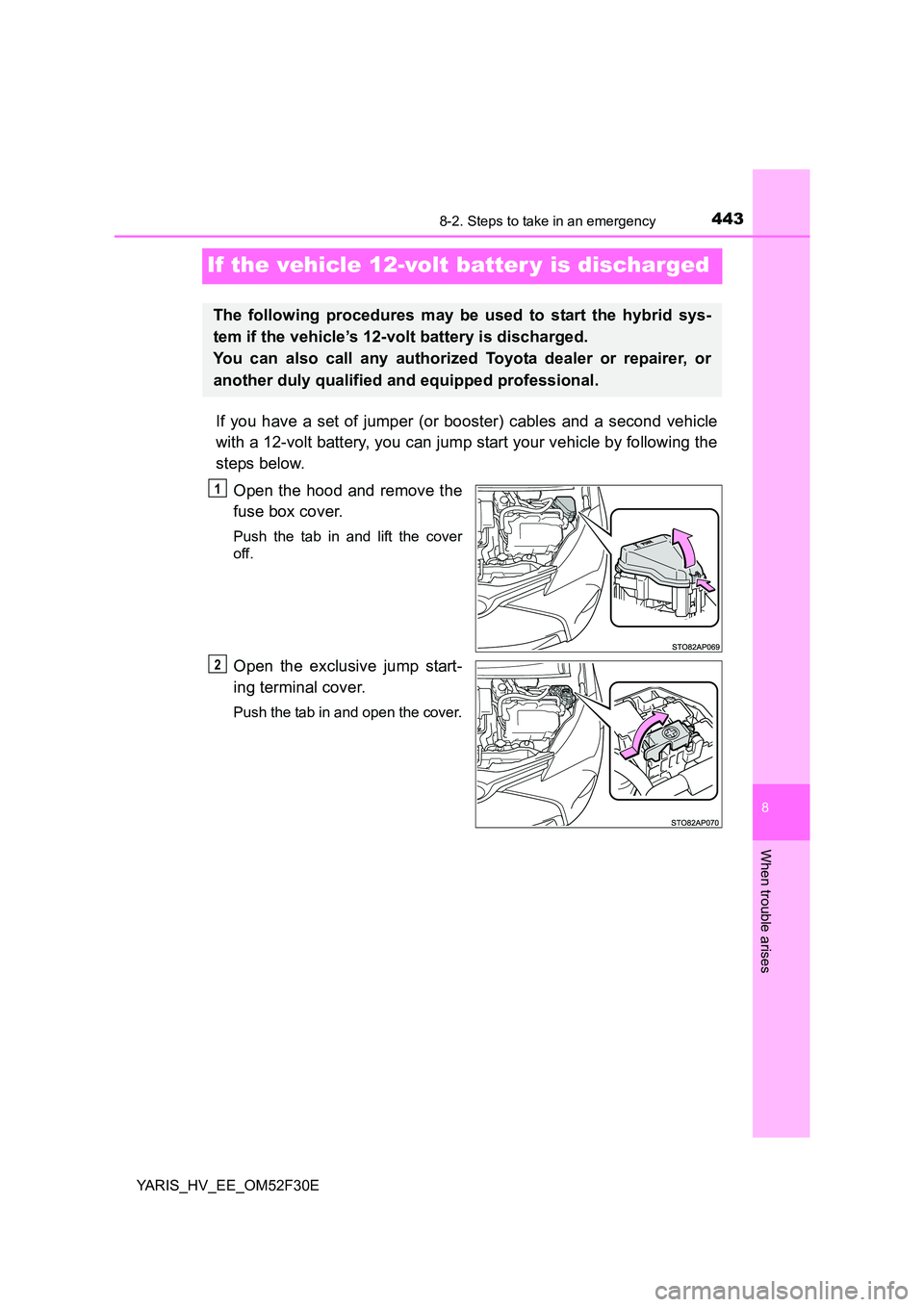
4438-2. Steps to take in an emergency
8
When trouble arises
YARIS_HV_EE_OM52F30E
If the vehicle 12-volt batter y is discharged
If you have a set of jumper (or booster) cables and a second vehicle
with a 12-volt battery, you can jump start your vehicle by following the
steps below.
Open the hood and remove the
fuse box cover.
Push the tab in and lift the cover
off.
Open the exclusive jump start-
ing terminal cover.
Push the tab in and open the cover.
The following procedures may be used to start the hybrid sys-
tem if the vehicle’s 12-volt battery is discharged.
You can also call any authorized Toyota dealer or repairer, or
another duly qualified and equipped professional.
1
2
Page 444 of 492
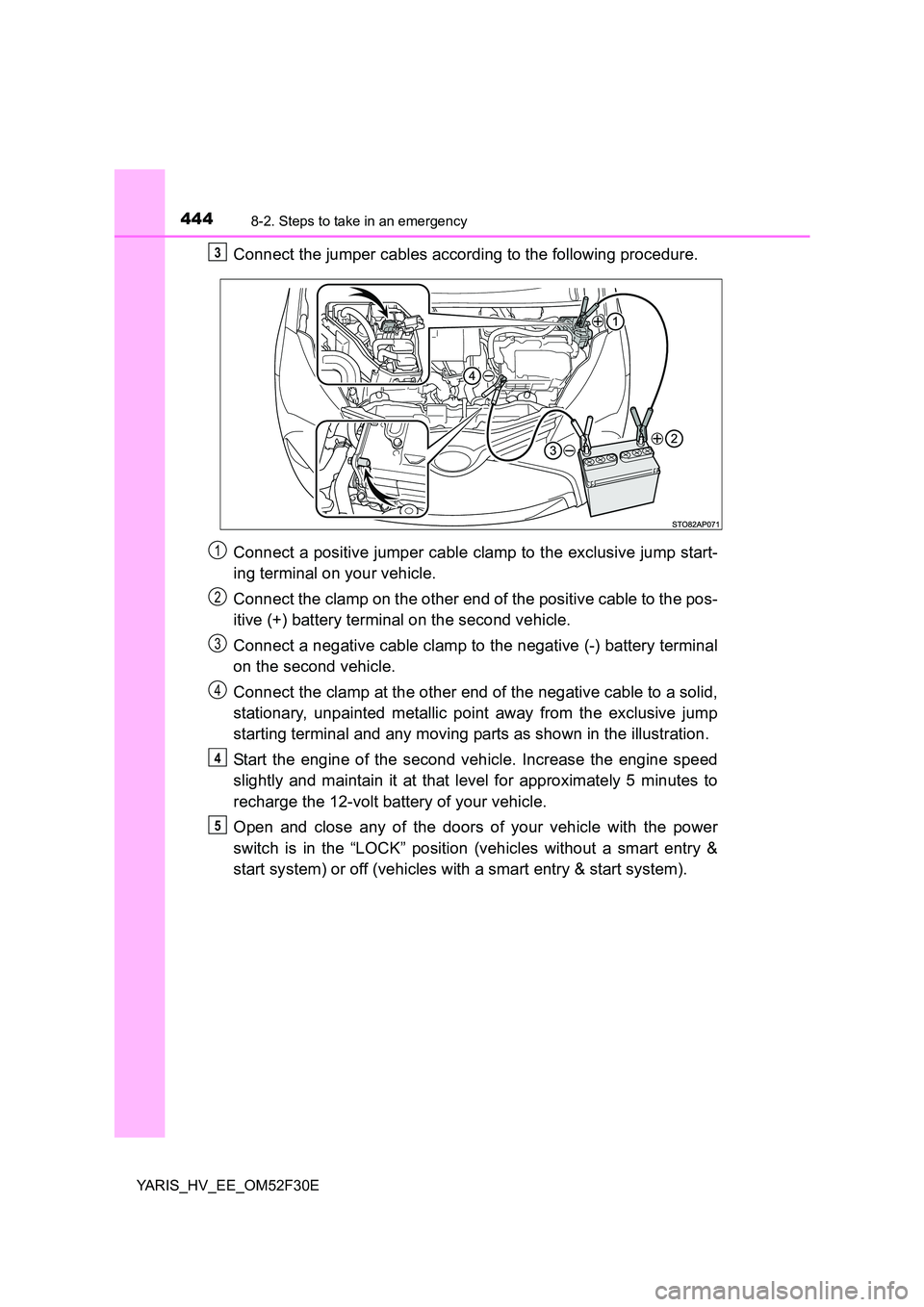
4448-2. Steps to take in an emergency
YARIS_HV_EE_OM52F30E
Connect the jumper cables according to the following procedure.
Connect a positive jumper cable clamp to the exclusive jump start-
ing terminal on your vehicle.
Connect the clamp on the other end of the positive cable to the pos-
itive (+) battery terminal on the second vehicle.
Connect a negative cable clamp to the negative (-) battery terminal
on the second vehicle.
Connect the clamp at the other end of the negative cable to a solid,
stationary, unpainted metallic point away from the exclusive jump
starting terminal and any moving parts as shown in the illustration.
Start the engine of the second vehicle. Increase the engine speed
slightly and maintain it at that level for approximately 5 minutes to
recharge the 12-volt battery of your vehicle.
Open and close any of the doors of your vehicle with the power
switch is in the “LOCK” position (vehicles without a smart entry &
start system) or off (vehicles with a smart entry & start system).
3
1
2
3
4
4
5
Page 445 of 492
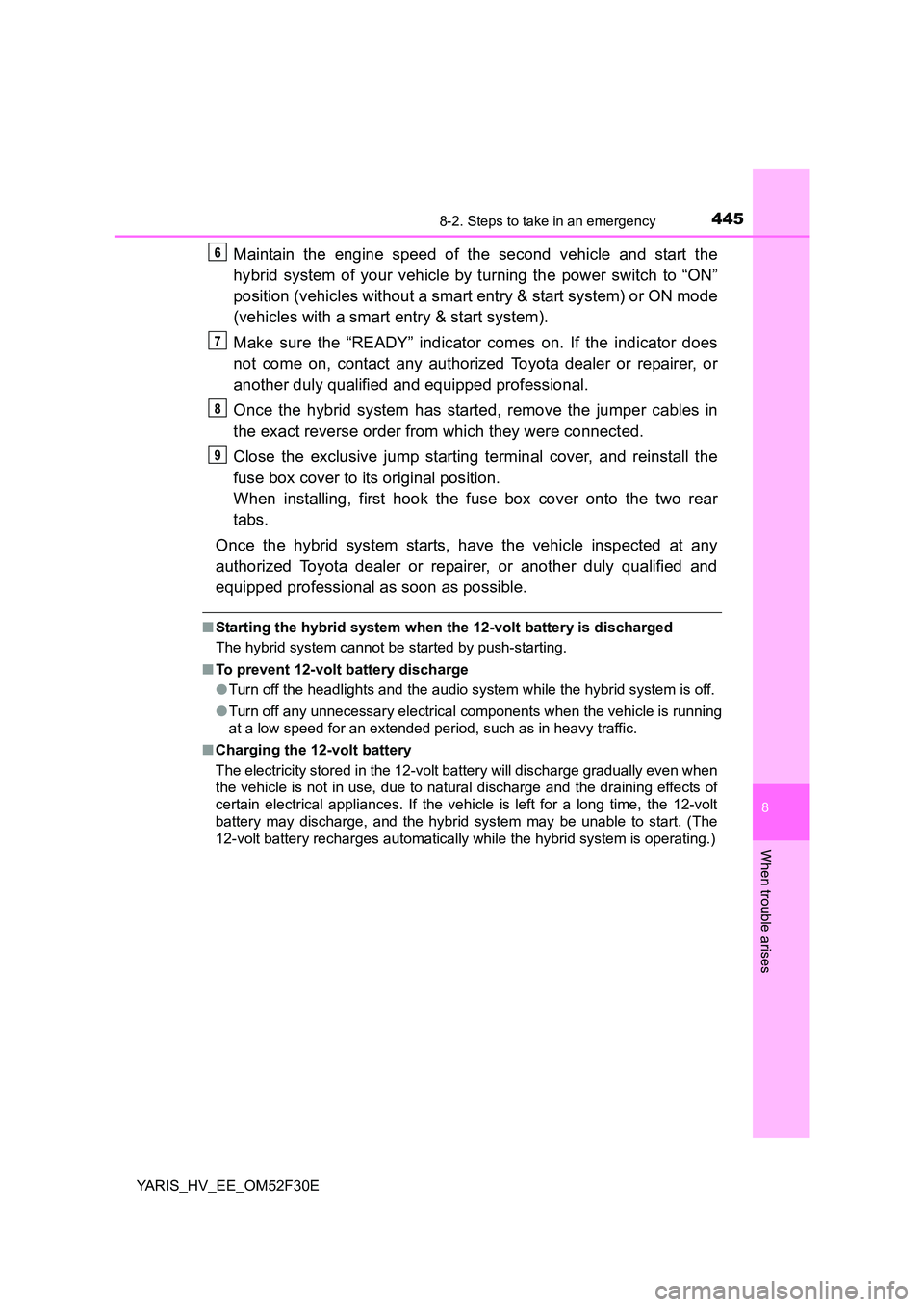
4458-2. Steps to take in an emergency
8
When trouble arises
YARIS_HV_EE_OM52F30E
Maintain the engine speed of the second vehicle and start the
hybrid system of your vehicle by turning the power switch to “ON”
position (vehicles without a smart entry & start system) or ON mode
(vehicles with a smart entry & start system).
Make sure the “READY” indicator comes on. If the indicator does
not come on, contact any authorized Toyota dealer or repairer, or
another duly qualified and equipped professional.
Once the hybrid system has started, remove the jumper cables in
the exact reverse order from which they were connected.
Close the exclusive jump starting terminal cover, and reinstall the
fuse box cover to its original position.
When installing, first hook the fuse box cover onto the two rear
tabs.
Once the hybrid system starts, have the vehicle inspected at any
authorized Toyota dealer or repairer, or another duly qualified and
equipped professional as soon as possible.
■ Starting the hybrid system when the 12-volt battery is discharged
The hybrid system cannot be started by push-starting.
■ To prevent 12-volt battery discharge
● Turn off the headlights and the audio system while the hybrid system is off.
● Turn off any unnecessary electrical components when the vehicle is running
at a low speed for an extended period, such as in heavy traffic.
■ Charging the 12-volt battery
The electricity stored in the 12-volt battery will discharge gradually even when
the vehicle is not in use, due to natural discharge and the draining effects of
certain electrical appliances. If the vehicle is left for a long time, the 12-volt
battery may discharge, and the hybrid system may be unable to start. (The
12-volt battery recharges automatically while the hybrid system is operating.)
6
7
8
9
Page 446 of 492
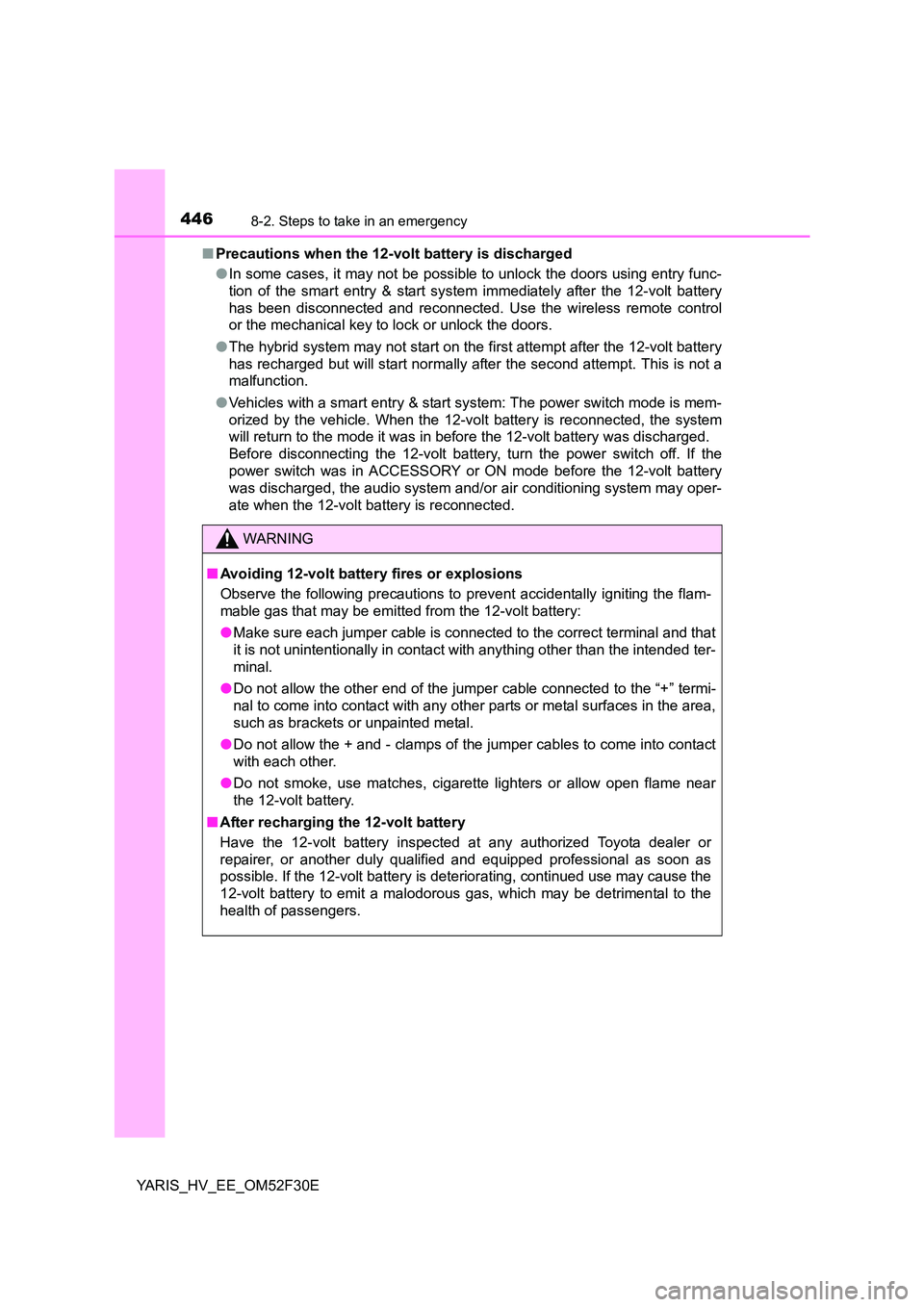
4468-2. Steps to take in an emergency
YARIS_HV_EE_OM52F30E
■ Precautions when the 12-volt battery is discharged
● In some cases, it may not be possible to unlock the doors using entry func-
tion of the smart entry & start system immediately after the 12-volt battery
has been disconnected and reconnected. Use the wireless remote control
or the mechanical key to lock or unlock the doors.
● The hybrid system may not start on the first attempt after the 12-volt battery
has recharged but will start normally after the second attempt. This is not a
malfunction.
● Vehicles with a smart entry & start system: The power switch mode is mem-
orized by the vehicle. When the 12-volt battery is reconnected, the system
will return to the mode it was in before the 12-volt battery was discharged.
Before disconnecting the 12-volt battery, turn the power switch off. If the
power switch was in ACCESSORY or ON mode before the 12-volt battery
was discharged, the audio system and/or air conditioning system may oper-
ate when the 12-volt battery is reconnected.
WARNING
■ Avoiding 12-volt battery fires or explosions
Observe the following precautions to prevent accidentally igniting the flam-
mable gas that may be emitted from the 12-volt battery:
● Make sure each jumper cable is connected to the correct terminal and that
it is not unintentionally in contact with anything other than the intended ter-
minal.
● Do not allow the other end of the jumper cable connected to the “+” termi-
nal to come into contact with any other parts or metal surfaces in the area,
such as brackets or unpainted metal.
● Do not allow the + and - clamps of the jumper cables to come into contact
with each other.
● Do not smoke, use matches, cigarette lighters or allow open flame near
the 12-volt battery.
■ After recharging the 12-volt battery
Have the 12-volt battery inspected at any authorized Toyota dealer or
repairer, or another duly qualified and equipped professional as soon as
possible. If the 12-volt battery is deteriorating, continued use may cause the
12-volt battery to emit a malodorous gas, which may be detrimental to the
health of passengers.
Page 447 of 492
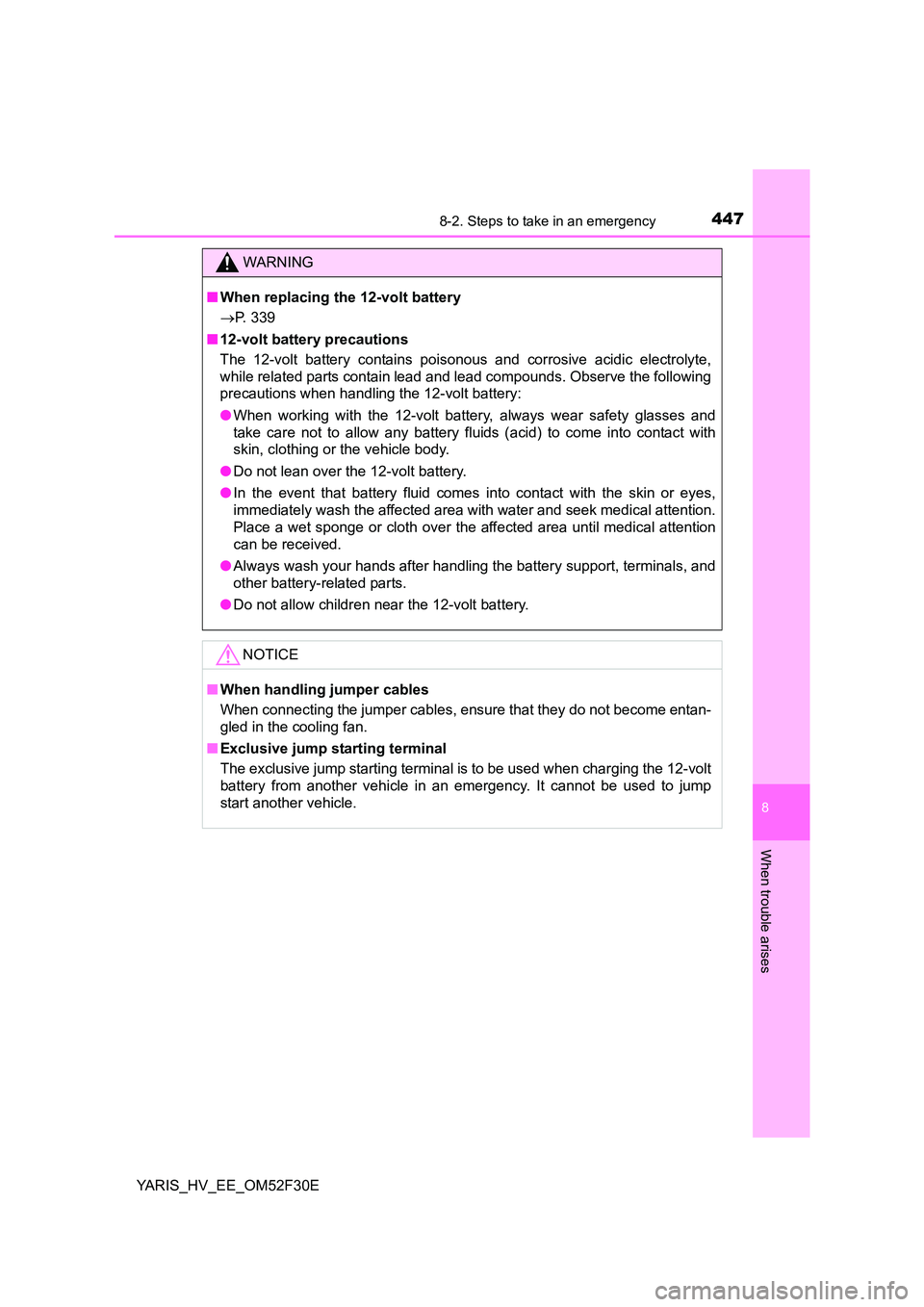
4478-2. Steps to take in an emergency
8
When trouble arises
YARIS_HV_EE_OM52F30E
WARNING
■ When replacing the 12-volt battery
→ P. 339
■ 12-volt battery precautions
The 12-volt battery contains poisonous and corrosive acidic electrolyte,
while related parts contain lead and lead compounds. Observe the following
precautions when handling the 12-volt battery:
● When working with the 12-volt battery, always wear safety glasses and
take care not to allow any battery fluids (acid) to come into contact with
skin, clothing or the vehicle body.
● Do not lean over the 12-volt battery.
● In the event that battery fluid comes into contact with the skin or eyes,
immediately wash the affected area with water and seek medical attention.
Place a wet sponge or cloth over the affected area until medical attention
can be received.
● Always wash your hands after handling the battery support, terminals, and
other battery-related parts.
● Do not allow children near the 12-volt battery.
NOTICE
■ When handling jumper cables
When connecting the jumper cables, ensure that they do not become entan-
gled in the cooling fan.
■ Exclusive jump starting terminal
The exclusive jump starting terminal is to be used when charging the 12-volt
battery from another vehicle in an emergency. It cannot be used to jump
start another vehicle.
Page 448 of 492
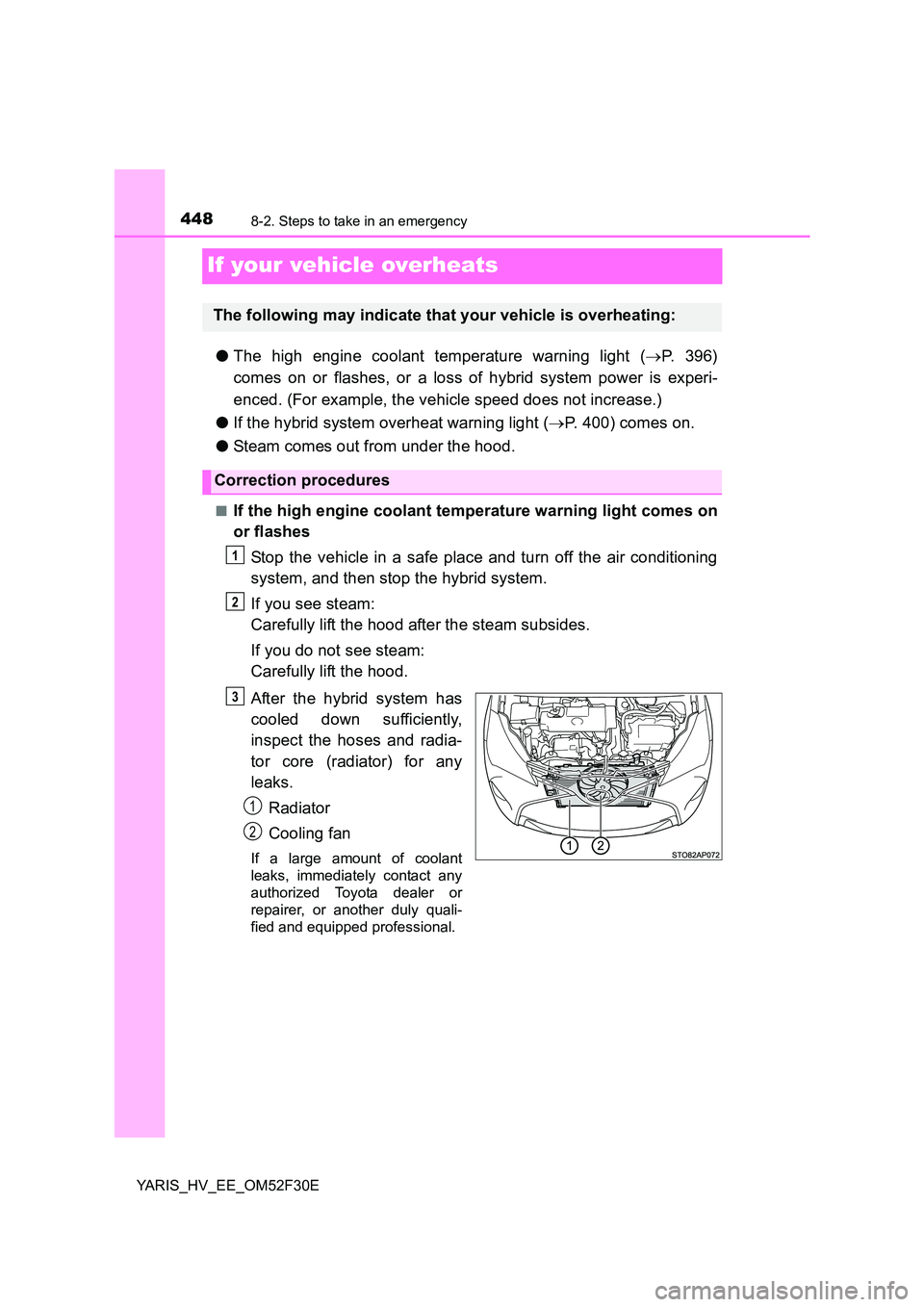
4488-2. Steps to take in an emergency
YARIS_HV_EE_OM52F30E
If your vehicle overheats
●The high engine coolant temperature warning light (→P. 396)
comes on or flashes, or a loss of hybrid system power is experi-
enced. (For example, the vehicle speed does not increase.)
● If the hybrid system overheat warning light (→P. 400) comes on.
● Steam comes out from under the hood.
■If the high engine coolant temperature warning light comes on
or flashes
Stop the vehicle in a safe place and turn off the air conditioning
system, and then stop the hybrid system.
If you see steam:
Carefully lift the hood after the steam subsides.
If you do not see steam:
Carefully lift the hood.
After the hybrid system has
cooled down sufficiently,
inspect the hoses and radia-
tor core (radiator) for any
leaks.
Radiator
Cooling fan
If a large amount of coolant
leaks, immediately contact any
authorized Toyota dealer or
repairer, or another duly quali-
fied and equipped professional.
The following may indicate that your vehicle is overheating:
Correction procedures
1
2
3
1
2
Page 449 of 492
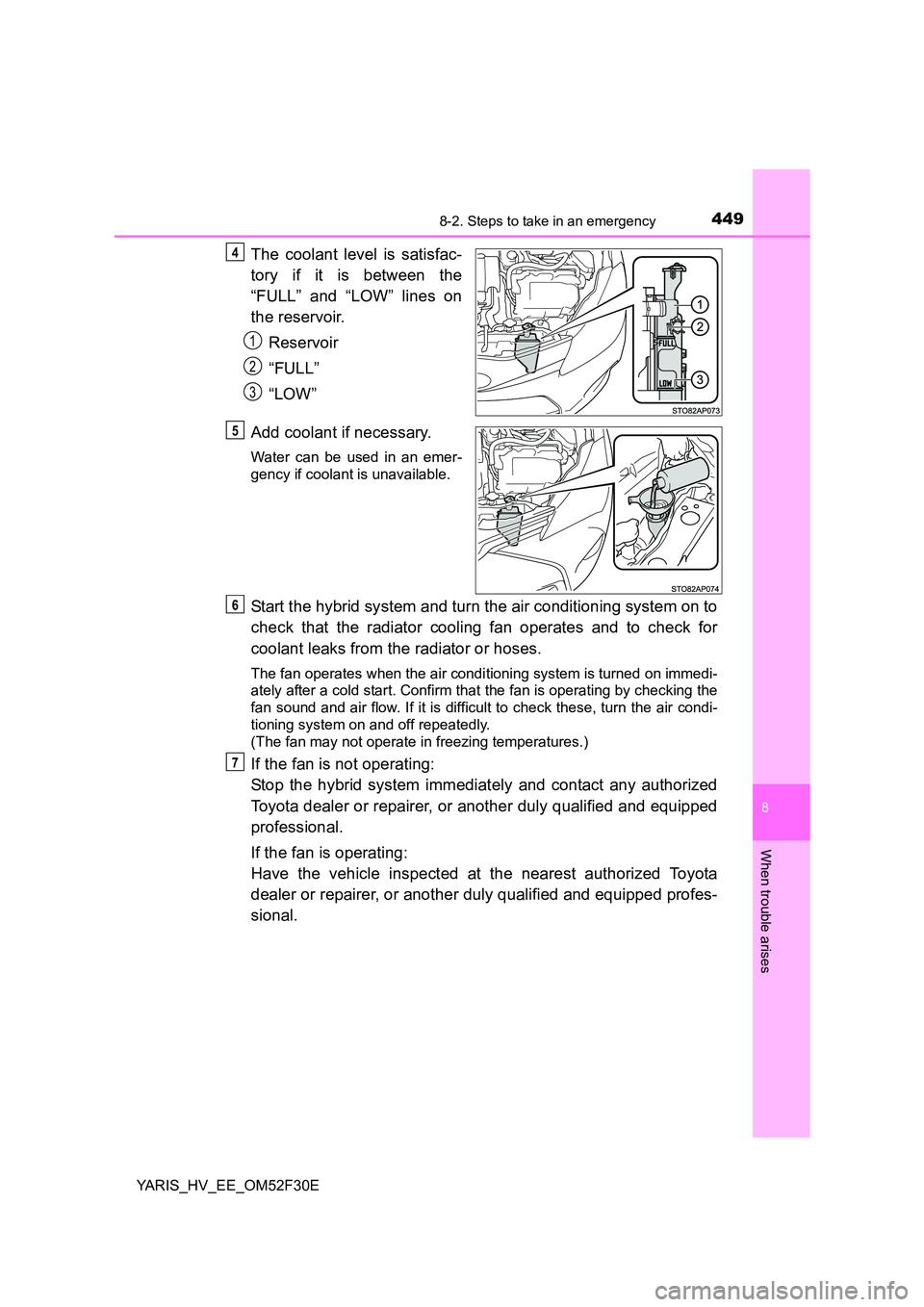
4498-2. Steps to take in an emergency
8
When trouble arises
YARIS_HV_EE_OM52F30E
The coolant level is satisfac-
tory if it is between the
“FULL” and “LOW” lines on
the reservoir.
Reservoir
“FULL”
“LOW”
Add coolant if necessary.
Water can be used in an emer-
gency if coolant is unavailable.
Start the hybrid system and turn the air conditioning system on to
check that the radiator cooling fan operates and to check for
coolant leaks from the radiator or hoses.
The fan operates when the air condi tioning system is turned on immedi-
ately after a cold start. Confirm that the fan is operating by checking the
fan sound and air flow. If it is difficult to check these, turn the air condi-
tioning system on and off repeatedly.
(The fan may not operate in freezing temperatures.)
If the fan is not operating:
Stop the hybrid system immediately and contact any authorized
Toyota dealer or repairer, or another duly qualified and equipped
professional.
If the fan is operating:
Have the vehicle inspected at the nearest authorized Toyota
dealer or repairer, or another duly qualified and equipped profes-
sional.
4
1
2
3
5
6
7
Page 450 of 492
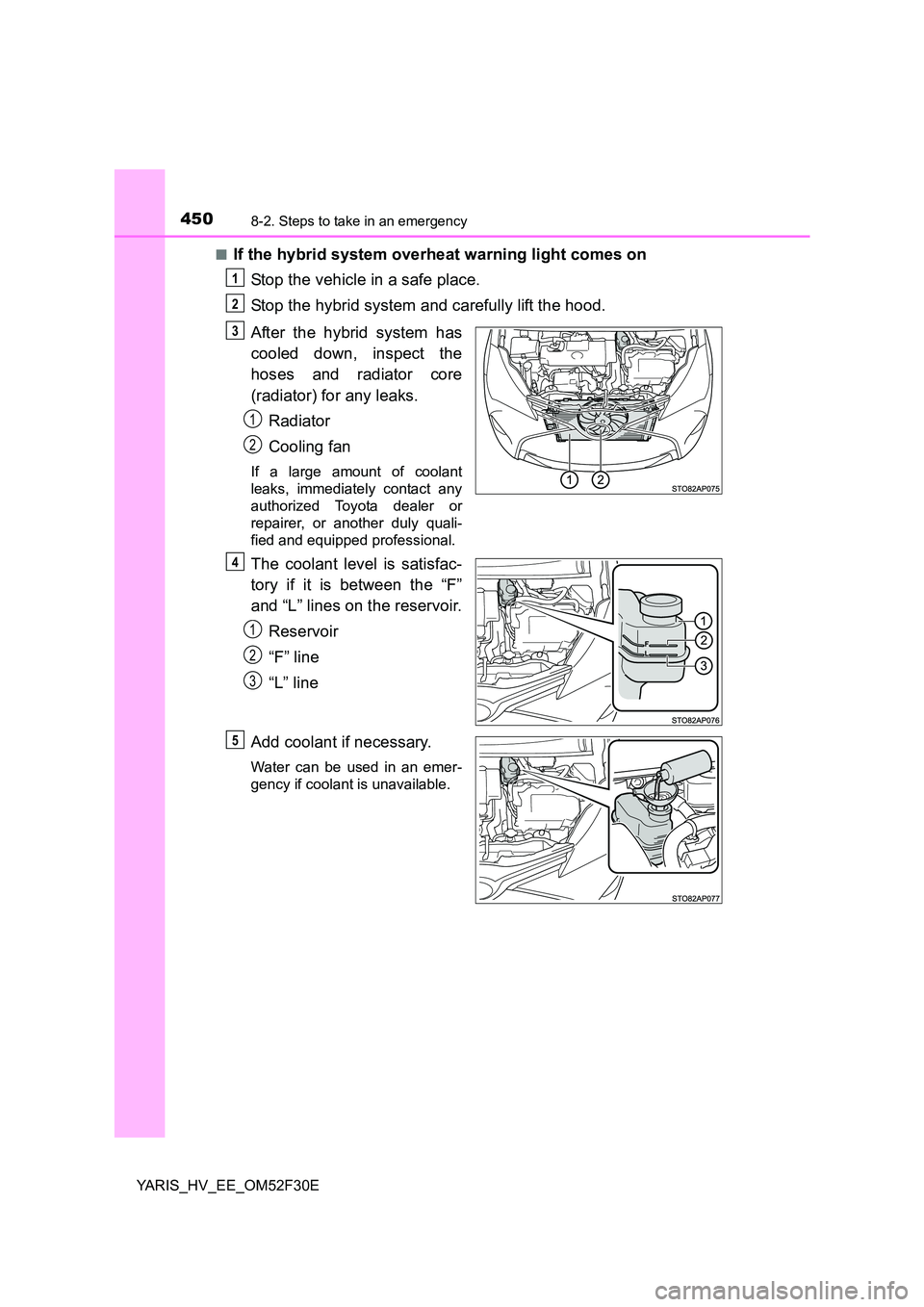
4508-2. Steps to take in an emergency
YARIS_HV_EE_OM52F30E
■If the hybrid system overheat warning light comes on
Stop the vehicle in a safe place.
Stop the hybrid system and carefully lift the hood.
After the hybrid system has
cooled down, inspect the
hoses and radiator core
(radiator) for any leaks.
Radiator
Cooling fan
If a large amount of coolant
leaks, immediately contact any
authorized Toyota dealer or
repairer, or another duly quali-
fied and equipped professional.
The coolant level is satisfac-
tory if it is between the “F”
and “L” lines on the reservoir.
Reservoir
“F” line
“L” line
Add coolant if necessary.
Water can be used in an emer-
gency if coolant is unavailable.
1
2
3
1
2
4
1
2
3
5